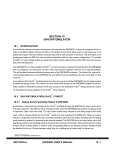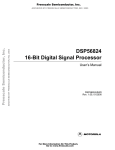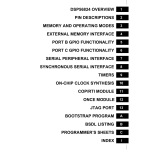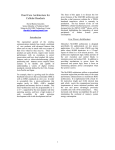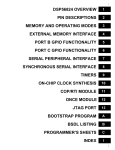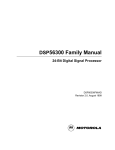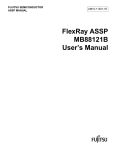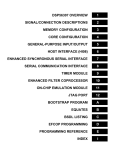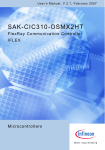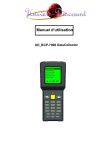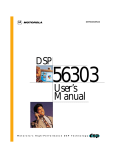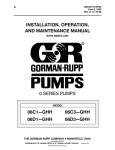Download SECTION 10 ON-CHIP EMULATION MODULE
Transcript
Freescale Semiconductor, Inc. ARCHIVED BY FREESCALE SEMICONDUCTOR, INC. 2005 SECTION 10 ARCHIVED BY FREESCALE SEMICONDUCTOR, INC. 2005 Freescale Semiconductor, Inc... ON-CHIP EMULATION MODULE MOTOROLA DSP56602 User’s Manual For More Information On This Product, Go to: www.freescale.com 10-1 Freescale Semiconductor, Inc. On-Chip Emulation Module ARCHIVED BY FREESCALE SEMICONDUCTOR, INC. 2005 Freescale Semiconductor, Inc... ARCHIVED BY FREESCALE SEMICONDUCTOR, INC. 2005 10.1 10.2 10.3 10.4 10.5 10.6 10.7 10.8 10.9 10.10 10.11 10.12 10-2 INTRODUCTION . . . . . . . . . . . . . . . . . . . . . . . . . . . . . . . . . . . .10-3 ONCE MODULE PINS. . . . . . . . . . . . . . . . . . . . . . . . . . . . . . . .10-3 ONCE CONTROLLER. . . . . . . . . . . . . . . . . . . . . . . . . . . . . . . .10-4 ONCE MEMORY BREAKPOINT LOGIC. . . . . . . . . . . . . . . . .10-10 ONCE TRACE LOGIC . . . . . . . . . . . . . . . . . . . . . . . . . . . . . . .10-15 METHODS OF ENTERING THE DEBUG MODE . . . . . . . . . .10-16 PIPELINE INFORMATION AND OGDBR . . . . . . . . . . . . . . . .10-18 TRACE BUFFER . . . . . . . . . . . . . . . . . . . . . . . . . . . . . . . . . . .10-20 ONCE COMMANDS AND SERIAL PROTOCOL . . . . . . . . . .10-23 TARGET SITE DEBUG SYSTEM REQUIREMENTS . . . . . . .10-24 EXAMPLES OF USING THE ONCE . . . . . . . . . . . . . . . . . . . .10-24 EXAMPLES OF JTAG AND ONCE INTERACTION . . . . . . . .10-29 DSP56602 User’s Manual For More Information On This Product, Go to: www.freescale.com MOTOROLA Freescale Semiconductor, Inc. On-Chip Emulation Module ARCHIVED BY FREESCALE SEMICONDUCTOR, INC. 2005 ARCHIVED BY FREESCALE SEMICONDUCTOR, INC. 2005 Freescale Semiconductor, Inc... 10.1 Introduction INTRODUCTION The DSP56600 core On-Chip Emulation (OnCE™) module provides a means of interacting with the DSP56600 core and its peripherals non-intrusively so that a user can examine registers, memory, or on-chip peripherals, thus facilitating hardware and software development on the DSP56600 core processor. To achieve this, special circuits and dedicated pins on the DSP56602 are defined to avoid sacrificing any user-accessible on-chip resource. The OnCE module resources can be accessed only after executing the JTAG instruction ENABLE_ONCE (these resources are accessible even when the chip is operating in Normal mode). See Section 12, JTAG Port, for a description of the JTAG functionality and its relation to the OnCE. Figure 10-1 shows the block diagram of the OnCE module. PDB PIL GDB Pipeline Information Trace Logic TCK Control Bus TDI OnCE Controller XAB YAB PAB TDO TRST DE Trace Buffer Breakpoint Logic Tags Buffer AA0702 Figure 10-1 OnCE Module Block Diagram 10.2 OnCE MODULE PINS The OnCE module controller functionality is accessed through the JTAG Test Access Port (TAP). There are no dedicated OnCE module pins for clock, data in, or data out. The JTAG pins TCK, TDI, and TDO are used to shift in and out data and instructions. See JTAG Pins on page 11-5 for the description of the JTAG pins. To facilitate emulation-specific functions, one additional pin, called DE, is provided on the DSP56602. MOTOROLA DSP56602 User’s Manual For More Information On This Product, Go to: www.freescale.com 10-3 Freescale Semiconductor, Inc. On-Chip Emulation Module ARCHIVED BY FREESCALE SEMICONDUCTOR, INC. 2005 The bidirectional open drain Debug Event pin (DE) provides a fast means of entering the Debug mode of operation from an external command controller (when input), as well as a fast means of acknowledging the entering of the Debug mode of operation to an external command controller (when output). The assertion of this pin by a command controller causes the DSP56600 core to finish the current instruction being executed, save the instruction pipeline information, enter the Debug mode, and wait for commands to be entered from the TDI line. If the DE pin is used to enter the Debug mode, then it must be deasserted after the OnCE port responds with an acknowledge and before sending the first OnCE command. The assertion of this pin by the DSP56600 core indicates that the DSP has entered the Debug mode and is waiting for commands to be entered from the TDI line. The DE pin also facilitates multiple processor connections, as shown in Figure 10-2. ARCHIVED BY FREESCALE SEMICONDUCTOR, INC. 2005 Freescale Semiconductor, Inc... OnCE Controller DE RESET (Optional) TDI TDI TDO TDI TDO TDI TDO TDO TMS TCK TRST AA0703 Figure 10-2 OnCE Module Multiprocessor Configuration In this way, the user can stop all the devices in the system when one of the devices enters the Debug mode. The user can also stop all the devices synchronously by asserting the DE line. 10.3 OnCE CONTROLLER The OnCE controller contains the following blocks: OnCE Command Register (OCR), OnCE Decoder, and the status/control register. Figure 10-3 illustrates a block diagram of the OnCE controller. 10-4 DSP56602 User’s Manual For More Information On This Product, Go to: www.freescale.com MOTOROLA Freescale Semiconductor, Inc. On-Chip Emulation Module ARCHIVED BY FREESCALE SEMICONDUCTOR, INC. 2005OnCE Controller TDI TCK OnCE Command Register ISBKPT Update OnCE Decoder ISDEBUG ISSWDBG ARCHIVED BY FREESCALE SEMICONDUCTOR, INC. 2005 Freescale Semiconductor, Inc... ISTRACE ISDR Status and Control Register Register Read Register Write TDO Mode Select AA0704 Figure 10-3 OnCE Controller Block Diagram 10.3.1 OnCE Command Register (OCR) The OnCE Command Register (OCR) is an 8-bit shift register that receives its serial data from the TDI pin. It holds the 8-bit commands to be used as input for the OnCE Decoder. The OCR is shown in Figure 10-4. OCR OnCE Command Register Reset = $00 Write Only 7 6 5 R/W GO EX 4 3 2 1 0 RS4 RS3 RS2 RS1 RS0 AA0106 Figure 10-4 OnCE Command Register 10.3.1.1 Register Select (RS[4:0])—Bits 0–4 The Register Select (RS[4:0]) bits define which register is source/destination for the read/write operation. Table 10-1 shows the OnCE register addresses. MOTOROLA DSP56602 User’s Manual For More Information On This Product, Go to: www.freescale.com 10-5 Freescale Semiconductor, Inc. On-Chip Emulation Module OnCE Controller ARCHIVED BY FREESCALE SEMICONDUCTOR, INC. 2005 Table 10-1 OnCE Register Select Encoding ARCHIVED BY FREESCALE SEMICONDUCTOR, INC. 2005 Freescale Semiconductor, Inc... RS[4:0] 10-6 Register Selected 00000 OnCE Status and Control Register (OSCR) 00001 OnCE Memory Breakpoint Counter (OMBC) 00010 OnCE Breakpoint Control Register (OBCR) 00011 (Reserved) 00100 (Reserved) 00101 Memory Limit Register 0 (OMLR0) 00110 Memory Limit Register 1 (OMLR1) 00111 (Reserved) 01000 (Reserved) 01001 OnCE Global Data Bus Register (OGDBR) 01010 OnCE Program Data Bus Register (OPDBR) 01011 OnCE PIL Register (OPILR) 01100 OnCE Program Data Bus GO-TO Register (for GO TO command) 01101 OnCE Trace Counter (OTC) 01110 (Reserved) 01111 OnCE PAB Register for Fetch (OPABFR) 10000 OnCE PAB Register for Decode (OPABDR) 10001 OnCE PAB Register for Execute (OPABEX) 10010 Trace Buffer and Increment Pointer 10011 (Reserved) 101xx (Reserved) 11xx0 (Reserved) 11x0x (Reserved) 110xx (Reserved) 11111 No Register Selected DSP56602 User’s Manual For More Information On This Product, Go to: www.freescale.com MOTOROLA Freescale Semiconductor, Inc. On-Chip Emulation Module ARCHIVED BY FREESCALE SEMICONDUCTOR, INC. 2005OnCE Controller 10.3.1.2 Exit Command (EX)—Bit 5 If the EX bit is set, leave Debug mode and resume normal operation. The EXIT command is executed only if the GO command is issued, and the operation is write to OPDBR or read/write to “No Register Selected”. Otherwise the EX bit is ignored. Table 10-2 shows the definition of the EX bit. ARCHIVED BY FREESCALE SEMICONDUCTOR, INC. 2005 Freescale Semiconductor, Inc... Table 10-2 EX Bit Definition EX Action 0 Remain in Debug mode 1 Leave Debug mode 10.3.1.3 GO Command (GO)—Bit 6 If the GO bit is set, execute the instruction that resides in the PIL register. To execute the instruction, the core leaves the Debug mode. The core returns to the Debug mode immediately after executing the instruction if the EX bit is cleared. The core goes on to normal operation if the EX bit is set. The GO command is executed only if the operation is write to OPDBR or read/write to “No Register Selected”. Otherwise, the GO bit is ignored. Table 10-3 shows the definition of the GO bit. Table 10-3 GO Bit Definition GO Action 0 Inactive—no action taken 1 Execute instruction in PIL 10.3.1.4 Read/Write Command (R/W)—Bit 7 The R/W bit specifies the direction of data transfer. Table 10-4 shows the definition of the R/W bit. Table 10-4 R/W Bit Definition R/W Action 0 Write the data associated with the command into the register specified by RS[4:0]. 1 Read the data contained in the register specified by RS[4:0]. MOTOROLA DSP56602 User’s Manual For More Information On This Product, Go to: www.freescale.com 10-7 Freescale Semiconductor, Inc. On-Chip Emulation Module ARCHIVED BY FREESCALE SEMICONDUCTOR, INC. 2005 OnCE Controller 10.3.2 OnCE Decoder (ODEC) The OnCE Decoder (ODEC) supervises the entire OnCE module activity. It receives as input the 8-bit command from the OCR, a signal from JTAG Controller (indicating that 8/24 bits have been received and update of the selected data register must be performed), and a signal indicating that the core was halted. The ODEC generates all the strobes required for reading and writing the selected OnCE registers. ARCHIVED BY FREESCALE SEMICONDUCTOR, INC. 2005 Freescale Semiconductor, Inc... 10.3.3 OnCE Status and Control Register (OSCR) The OnCE Status and Control Register (OSCR) is a 24-bit register used to enable the Trace mode of operation and to indicate the cause of entering the Debug mode. The control bits are read/write while the status bits are read-only. The OSCR bits are cleared on hardware reset. The OSCR is shown in Figure 10-5. 23 OnCE Status and Control Register Read/Write * * * * * * 9 8 * * 7 6 OS1 OS0 5 * 4 3 2 1 0 TO MBO SWO IME TME * Indicates reserved bits, written as 0 for future compatibility AA0705 Figure 10-5 OnCE Status and Control Register (OSCR) 10.3.3.1 Trace Mode Enable (TME)—Bit 0 When the Trace Mode Enable (TME) control bit is set, the Trace mode of operation is enabled. 10.3.3.2 Interrupt Mode Enable (IME)—Bit 1 The Interrupt Mode Enable (IME) control bit, when set, causes the chip to execute a vectored interrupt to the address VBA:$06 instead of entering the Debug mode. 10.3.3.3 Software Debug Occurrence (SWO)—Bit 2 The Software Debug Occurrence (SWO) bit is a read-only status bit that is set when the Debug mode of operation is entered because of the execution of the DEBUG or DEBUGcc instruction with condition true. This bit is cleared when leaving the Debug mode. 10-8 DSP56602 User’s Manual For More Information On This Product, Go to: www.freescale.com MOTOROLA Freescale Semiconductor, Inc. On-Chip Emulation Module ARCHIVED BY FREESCALE SEMICONDUCTOR, INC. 2005OnCE Controller 10.3.3.4 Memory Breakpoint Occurrence (MBO)—Bit 3 The Memory Breakpoint Occurrence (MBO) bit is a read-only status bit that is set when the Debug mode of operation is entered because a memory breakpoint has been encountered. This bit is cleared when leaving the Debug mode. ARCHIVED BY FREESCALE SEMICONDUCTOR, INC. 2005 Freescale Semiconductor, Inc... 10.3.3.5 Trace Occurrence (TO)—Bit 4 The Trace Occurrence (TO) bit is a read-only status bit that is set when the Debug mode of operation is entered when the Trace Counter is zero while Trace mode is enabled. This bit is cleared when leaving the Debug mode. 10.3.3.6 Reserved Bit—Bit 5 Bit 5 of the OSCR is reserved for future use. It is read as 0 and should be written with 0 for future compatibility. 10.3.3.7 Core Status (OS[1:0])—Bits 6-7 The Core Status (OS[1:0]) bits are read-only status bits that provide core status information. By examining the status bits, the user can determine whether the chip has entered the Debug mode. Examining SWO, MBO, and TO identifies the cause of entering the Debug mode. The user can also examine these bits and determine the cause why the chip has not entered the Debug mode after debug event assertion (DE) or as a result of the execution of the JTAG DEBUG_REQUEST instruction (core waiting for the bus, STOP or WAIT instruction, etc.). These bits are also reflected in the JTAG Instruction shift Register (IR), which allows the polling of the core status information at the JTAG level. This is useful when the DSP56600 core executes the STOP instruction (and therefore there are no clocks) to allow the reading of OSCR. See Table 10-5 for the definition of the OS[1:0] bits. Table 10-5 Core Status Bits Description OS[1:0] Description 00 DSP56600 core is executing instructions 01 DSP56600 core is in Wait or Stop mode 10 DSP56600 core is waiting for bus 11 DSP56600 core is in Debug mode 10.3.3.8 Reserved Bits—Bits 8–23 Bits 8–23 of the OSCR are reserved for future use. They are read as 0 and should be written with 0 for future compatibility. MOTOROLA DSP56602 User’s Manual For More Information On This Product, Go to: www.freescale.com 10-9 Freescale Semiconductor, Inc. On-Chip Emulation Module ARCHIVED OnCE Memory Breakpoint Logic BY FREESCALE SEMICONDUCTOR, INC. 2005 10.4 OnCE MEMORY BREAKPOINT LOGIC TCK ARCHIVED BY FREESCALE SEMICONDUCTOR, INC. 2005 Freescale Semiconductor, Inc... Memory breakpoints can be set on program memory or data memory locations. In addition, the breakpoint does not have to be in a specific memory address, but within an approximate address range of where the program may be executing. This significantly increases the programmer’s ability to monitor what the program is doing in real-time. The breakpoint logic, described in Figure 10-6, contains a latch for the addresses, registers that store the upper and lower address limit, address comparators, and a breakpoint counter. PAB XAB YAB TDO TDI Memory Address Latch Memory Bus Select TDI TCK TDO N,V Address Comparator 0 Breakpoint Control Memory Limit Register 0 Address Comparator 1 N,V Memory Breakpoint Selection Memory Limit Register 1 Breakpoint Counter DEC Breakpoint Occurred Count = 0 ISBKPT AA0706 Figure 10-6 OnCE Memory Breakpoint Logic 0 Address comparators are useful in determining where a program may be getting lost or when data is being written where it should not be written. They are also useful in halting a program at a specific point to examine/change registers or memory. Using address comparators to set breakpoints enables the user to set breakpoints in RAM or ROM and while in any operating mode. Memory accesses are monitored according to the contents of the OBCR as specified in OnCE Breakpoint Control Register (OBCR) on page 10-12. 10-10 DSP56602 User’s Manual For More Information On This Product, Go to: www.freescale.com MOTOROLA Freescale Semiconductor, Inc. On-Chip Emulation Module ARCHIVED BY FREESCALE SEMICONDUCTOR, INC. 2005Breakpoint Logic OnCE Memory 10.4.1 OnCE Memory Address Latch (OMAL) The OnCE Memory Address Latch (OMAL) is a 16-bit register that latches the PAB, XAB or YAB on every instruction cycle according to the MBS1–MBS0 bits in OBCR. ARCHIVED BY FREESCALE SEMICONDUCTOR, INC. 2005 Freescale Semiconductor, Inc... 10.4.2 OnCE Memory Limit Register 0 (OMLR0) The OnCE Memory Limit Register 0 (OMLR0) is a 16-bit register that stores the memory breakpoint limit.Before enabling breakpoints, OMLR0 must be loaded by the external command controller. OMLR0 can be read or written through the TAP. 10.4.3 OnCE Memory Address Comparator 0 (OMAC0) The OnCE Memory Address Comparator 0 (OMAC0) compares the current memory address (stored in OMAL0) with the OMLR0 contents. 10.4.4 OnCE Memory Limit Register 1 (OMLR1) The OnCE Memory Limit Register 1 (OMLR1) is a 16-bit register that stores the memory breakpoint limit. OMLR1 can be read or written through the TAP. Before enabling breakpoints, OMLR1 must be loaded by the external command controller. 10.4.5 OnCE Memory Address Comparator 1 (OMAC1) The OnCE Memory Address Comparator 1 (OMAC1) compares the current memory address (stored in OMAL0) with the OMLR1 contents. MOTOROLA DSP56602 User’s Manual For More Information On This Product, Go to: www.freescale.com 10-11 Freescale Semiconductor, Inc. On-Chip Emulation Module ARCHIVED OnCE Memory Breakpoint Logic BY FREESCALE SEMICONDUCTOR, INC. 2005 10.4.6 OnCE Breakpoint Control Register (OBCR) 15 14 13 12 * * * * OnCE Breakpoint Control Register Reset = $0010 Read/Write 11 10 BT1 BT0 9 8 7 6 5 4 3 2 1 0 CC 11 CC 10 RW 11 RW 10 CC 01 CC 00 RW 01 RW 00 MB S1 MB S0 * Indicates reserved bits, written as 0 for future compatibility ARCHIVED BY FREESCALE SEMICONDUCTOR, INC. 2005 Freescale Semiconductor, Inc... The OnCE Breakpoint Control Register (OBCR) is a 16-bit register used to define the memory breakpoint events. OBCR can be read or written through the JTAG TAP. All the bits of the OBCR are cleared on hardware reset. The OBCR is described in Figure 10-7. AA0707 Figure 10-7 OnCE Breakpoint Control Register (OBCR) 10.4.6.1 Memory Breakpoint Select Bits (MBS[1:0])—Bits 0–1 The Memory Breakpoint Select (MBS[1:0]) bits enable memory Breakpoint0 and Breakpoint1, allowing them to occur when a memory access is performed on P, X, or Y space access is performed. See Table 10-6 for the definition of the MBS[1:0] bits. Table 10-6 Memory Breakpoint Select Table MBS1 MBS0 Description 0 0 Reserved 0 1 Breakpoint on P access 1 0 Breakpoint on X access 1 1 Breakpoint on Y access 10.4.6.2 Breakpoint0 Read/Write Select (RW0[1:0])—Bits 2–3 The Breakpoint 0 Read/Write Select (RW0[1:0]) bits define the memory Breakpoint0 to occur when a memory address accesses is performed for read, write or both. See Table 10-7 for the definition of the RW0[1:0] bits. 10-12 DSP56602 User’s Manual For More Information On This Product, Go to: www.freescale.com MOTOROLA Freescale Semiconductor, Inc. On-Chip Emulation Module ARCHIVED BY FREESCALE SEMICONDUCTOR, INC. 2005Breakpoint Logic OnCE Memory ARCHIVED BY FREESCALE SEMICONDUCTOR, INC. 2005 Freescale Semiconductor, Inc... Table 10-7 Breakpoint0 Read/Write Select Table RW01 RW00 Description 0 0 Breakpoint disabled 0 1 Breakpoint on write access 1 0 Breakpoint on read access 1 1 Breakpoint on read or write access 10.4.6.3 Breakpoint0 CC Select (CC0[1:0])—Bits 4–5 The Breakpoint0 Condition Code Select (CC0[1:0]) bits define the condition of the comparison between the current Memory Address (OMAL0) and the Memory Limit Register 0 (OMLR0). See Table 10-8 for the definition of the CC0[1:0] bits. Table 10-8 Breakpoint0 Condition Select Table CC01 CC00 Description 0 0 Breakpoint on not equal 0 1 Breakpoint on equal 1 0 Breakpoint on less than 1 1 Breakpoint on greater than 10.4.6.4 Breakpoint1 Read/Write Select (RW1[1:0])—Bits 6–7 The Breakpoint1 Read/Write Select (RW1[1:0]) bits control define memory Breakpoints1 to occur when a memory address accesses is performed for read, write or both. See Table 10-9 for the definition of the RW1[1:0] bits. Table 10-9 Breakpoint1 Read/Write Select Table RW11 RW10 0 0 Breakpoint disabled 0 1 Breakpoint on write access 1 0 Breakpoint on read access 1 1 Breakpoint read or write access MOTOROLA Description DSP56602 User’s Manual For More Information On This Product, Go to: www.freescale.com 10-13 Freescale Semiconductor, Inc. On-Chip Emulation Module ARCHIVED OnCE Memory Breakpoint Logic BY FREESCALE SEMICONDUCTOR, INC. 2005 10.4.6.5 Breakpoint1 CC Select (CC1[1:0])—Bits 8–9 The Breakpoint1 Condition Code Select (CC1[1:0]) bits define the condition of the comparison between the current memory address (OMAL0) and the OnCE Memory Limit Register 1 (OMLR1). See Table 10-10 for the definition of the CC1[1:0] bits. ARCHIVED BY FREESCALE SEMICONDUCTOR, INC. 2005 Freescale Semiconductor, Inc... Table 10-10 Breakpoint1 Condition Select Table CC11 CC10 Description 0 0 Breakpoint on not equal 0 1 Breakpoint on equal 1 0 Breakpoint on less than 1 1 Breakpoint on greater than 10.4.6.6 Breakpoint Event Select Bits (BT[1:0])—Bits 10–11 The Breakpoint Event Select (BT[1:0]) bits define the sequence between Breakpoint0 and Breakpoint1. If the condition defined by BT[1:0] is met, then the Breakpoint Counter (OMBC) is decremented. See Table 10-11 for the definition of the BT[1:0] bits. Table 10-11 Breakpoint0 and Breakpoint1 Event Select Table BT1 BT0 Description 0 0 Breakpoint0 and Breakpoint1 0 1 Breakpoint0 or Breakpoint1 1 0 Breakpoint1 after Breakpoint0 1 1 Breakpoint0 after Breakpoint1 10.4.6.7 Reserved Bits—Bits 12–15 Bits 12–15 of the OBCR are reserved for future use. They are read as 0 and should be written with 0 for future compatibility. 10.4.7 OnCE Memory Breakpoint Counter (OMBC) The OnCE Memory Breakpoint Counter (OMBC) is a 16-bit counter that is loaded with a value equal to the number of times minus one that a memory access event should occur before a memory breakpoint is declared. The memory access event is specified by the OBCR and by the memory limit registers. On each occurrence of the memory access 10-14 DSP56602 User’s Manual For More Information On This Product, Go to: www.freescale.com MOTOROLA Freescale Semiconductor, Inc. On-Chip Emulation Module ARCHIVED BY FREESCALE SEMICONDUCTOR, INC. 2005 OnCE Trace Logic event, the breakpoint counter is decremented. When the counter reaches 0 and a new occurrence takes place, the chip enters the Debug mode. The OMBC can be read or written through the TAP. Every time that the limit register is changed, or a different breakpoint event is selected in the OBCR, the breakpoint counter must be written afterwards. This ensures that the OnCE breakpoint logic is reset and that no previous events can affect the new breakpoint event selected. The breakpoint counter is cleared by hardware reset. ARCHIVED BY FREESCALE SEMICONDUCTOR, INC. 2005 Freescale Semiconductor, Inc... 10.5 OnCE TRACE LOGIC Using the OnCE Trace Logic, execution of instructions in single or multiple steps is possible. The OnCE Trace Logic causes the chip to enter the Debug mode of operation after the execution of one or more instructions and wait for OnCE commands from the debug serial port. The OnCE Trace Logic block diagram is shown in Figure 10-8. End of Instruction TDI TDO Trace Counter DEC TCK Count = 0 ISTRACE AA0708 Figure 10-8 OnCE Trace Logic Block Diagram The Trace mode has a counter associated with it so that more than one instruction can be executed before returning back to the Debug mode of operation. The objective of the counter is to allow the user to take multiple instruction steps real-time before entering the Debug mode. This feature helps the software developer debug sections of code that do not have a normal flow or are getting hung up in infinite loops. The Trace Counter also enables the user to count the number of instructions executed in a code segment. The OnCE Trace Counter (OTC) is a 16-bit counter that can be read or written through the TAP. If N instructions are to be executed before entering the Debug mode, the Trace Counter should be loaded with N – 1. The Trace Counter is cleared by hardware reset. MOTOROLA DSP56602 User’s Manual For More Information On This Product, Go to: www.freescale.com 10-15 Freescale Semiconductor, Inc. On-Chip Emulation Module ARCHIVED BY FREESCALE SEMICONDUCTOR, INC. 2005 Methods of Entering the Debug Mode To enable the Trace mode of operation, do the following: 1. Load the counter with a value. 2. Set the program counter to the start location of the instruction(s) to be executed real-time. 3. Set the TME bit in the OSCR. ARCHIVED BY FREESCALE SEMICONDUCTOR, INC. 2005 Freescale Semiconductor, Inc... 4. Cause the DSP56600 core to exit the Debug mode by executing the appropriate command issued by the external command controller. Upon exiting the Debug mode, the counter is decremented after each execution of an instruction. Interrupts are serviceable and all instructions executed, including fast interrupt services and the execution of each repeated instruction, cause the Trace Counter to be decremented. Upon decrementing to 0, the DSP56600 core re-enters the Debug mode, the Trace Occurrence bit (TO) in the OSCR register is set, the core Status bits OS[1:0] are set to 11, and the DE pin is asserted to indicate that the DSP56600 core has entered Debug mode and is requesting service. 10.6 METHODS OF ENTERING THE DEBUG MODE Entering the Debug mode is acknowledged by the chip by setting the OS[1:0] bits and asserting the DE line. This informs the external command controller that the chip has entered the Debug mode and is waiting for commands.The DSP56600 core can disable the OnCE module if the ROM Security option is implemented. If the ROM Security is implemented, the OnCE module remains inactive until a write operation to the OGDBR is executed by the DSP56600 core. 10.6.1 External Debug Request During RESET Assertion Holding the DE line asserted during the assertion of RESET causes the chip to enter the Debug mode. After receiving the acknowledge, the external command controller must negate the DE line before sending the first command. Note: 10-16 In this case, the chip does not execute any instruction before entering the Debug mode. DSP56602 User’s Manual For More Information On This Product, Go to: www.freescale.com MOTOROLA Freescale Semiconductor, Inc. On-Chip Emulation Module ARCHIVED BY FREESCALE SEMICONDUCTOR, 2005the Debug Mode Methods of INC. Entering 10.6.2 External Debug Request During Normal Activity Holding the DE line asserted during normal chip activity causes the chip to finish the execution of the current instruction and then enter the Debug mode. After receiving the acknowledge, the external command controller must negate the DE line before sending the first command. This process is the same for any newly fetched instruction, including instructions fetched by the interrupt processing or instructions that will be aborted by the interrupt processing. ARCHIVED BY FREESCALE SEMICONDUCTOR, INC. 2005 Freescale Semiconductor, Inc... Note: 10.6.3 In this case the chip completes the execution of the current instruction and stops after the newly fetched instruction enters the instruction latch. Executing the JTAG DEBUG_REQUEST Instruction Executing the JTAG instruction DEBUG_REQUEST asserts an internal debug request signal. Consequently, the chip finishes the execution of the current instruction and stops after the newly fetched instruction enters the instruction latch. After entering the Debug mode, the Core Status bits OS1 and OS0 are set and the DE line is asserted, thus acknowledging the external command controller that the Debug mode of operation has been entered. 10.6.4 External Debug Request During Stop Mode Executing the JTAG instruction DEBUG_REQUEST (or asserting DE) while the chip is in the Stop state (i. e., has executed a STOP instruction) causes the chip to exit the Stop state and enter the Debug mode. After receiving the acknowledge, the external command controller must negate DE before sending the first command. Note: 10.6.5 In this case, the chip completes the execution of the STOP instruction and halts after the next instruction enters the instruction latch. External Debug Request During Wait Mode Executing the JTAG instruction DEBUG_REQUEST (or asserting DE) while the chip is in the Wait state (i. e., has executed a WAIT instruction) causes the chip to exit the Wait state and enter the Debug mode. After receiving the acknowledge, the external command controller must negate DE before sending the first command. MOTOROLA DSP56602 User’s Manual For More Information On This Product, Go to: www.freescale.com 10-17 Freescale Semiconductor, Inc. On-Chip Emulation Module ARCHIVED Pipeline Information and OGDBR BY FREESCALE SEMICONDUCTOR, INC. 2005 Note: 10.6.6 In this case, the chip completes the execution of the WAIT instruction and halts after the next instruction enters the instruction latch. Software Request During Normal Activity ARCHIVED BY FREESCALE SEMICONDUCTOR, INC. 2005 Freescale Semiconductor, Inc... Upon executing the DEBUG instruction (or DEBUGcc when the specified condition is true), the chip enters the Debug mode after the instruction following the DEBUG instruction has entered the instruction latch. 10.6.7 Enabling Trace Mode When the Trace mode mechanism is enabled and the Trace Counter is greater than zero, the Trace Counter is decremented after each instruction execution. Execution of an instruction when the value in the Trace Counter is 0 causes the chip to enter the Debug mode after completing the execution of the instruction. Only instructions actually executed cause the Trace Counter to decrement. An aborted instruction does not decrement the Trace Counter and does not cause the chip to enter the Debug mode. 10.6.8 Enabling Memory Breakpoints When the memory breakpoint mechanism is enabled with a Breakpoint Counter value of 0, the chip enters the Debug mode after completing the execution of the instruction that caused the memory breakpoint to occur. In case of breakpoints on executed Program memory fetches, the breakpoint is acknowledged immediately after the execution of the fetched instruction. In case of breakpoints on accesses to X, Y, or P memory spaces by MOVE instructions, the breakpoint is acknowledged after the completion of the instruction following the instruction that accessed the specified address. 10.7 PIPELINE INFORMATION AND OGDBR To restore the pipeline and to resume normal chip activity upon returning from the Debug mode, a number of on-chip registers store the chip pipeline status. Figure 10-9 shows the block diagram of the Pipeline Information Registers, with the exception of the PAB registers, which are shown in Figure 10-10 on page 10-22. 10-18 DSP56602 User’s Manual For More Information On This Product, Go to: www.freescale.com MOTOROLA Freescale Semiconductor, Inc. On-Chip Emulation Module ARCHIVED BY FREESCALE SEMICONDUCTOR, 2005 PipelineINC. Information and OGDBR GDB Register (OGDBR) GDB PDB Register (OPDBR) TDI PDB TDO ARCHIVED BY FREESCALE SEMICONDUCTOR, INC. 2005 Freescale Semiconductor, Inc... PIL Register (OPILR) TCK PIL AA0709 Figure 10-9 OnCE Pipeline Information and GDB Registers 10.7.1 OnCE PDB Register (OPDBR) The OnCE Program Data Bus Register (OPDBR) is a 24-bit latch that stores the value of the Program Data Bus generated by the last program memory access of the core before the Debug mode is entered. The OPDBR register can be read or written through the TAP. This register is affected by the operations performed during the Debug mode and must be restored by the external command controller when returning to Normal mode. 10.7.2 OnCE PIL Register (OPILR) The OnCE PIL Register (OPILR) is a 24-bit latch that stores the value of the Instruction Latch before the Debug mode is entered. OPILR can only be read through the TAP. Note: Since the Instruction Latch is affected by the operations performed during the Debug mode, it must be restored by the external command controller when returning to Normal mode. Since there is no direct write access to the Instruction Latch, the task of restoring is accomplished by writing to OPDBR with no-GO and no-EX. In this case, the data written on PDB is transferred into the Instruction Latch. MOTOROLA DSP56602 User’s Manual For More Information On This Product, Go to: www.freescale.com 10-19 Freescale Semiconductor, Inc. On-Chip Emulation Module Trace Buffer 10.7.3 ARCHIVED BY FREESCALE SEMICONDUCTOR, INC. 2005 OnCE GDB Register (OGDBR) ARCHIVED BY FREESCALE SEMICONDUCTOR, INC. 2005 Freescale Semiconductor, Inc... The OnCE GDB Register (OGDBR) is a 16-bit latch that can only be read through the TAP. The OGDBR is not actually required from a pipeline status restore point of view, but is required as a means of passing information between the chip and the external command controller. The OGDBR is mapped on the X internal I/O space at address $FFFB. Whenever the external command controller needs the contents of a register or memory location, it forces the chip to execute an instruction that brings that information to the OGDBR. Then the contents of the OGDBR are delivered serially to the external command controller by the command “READ GDB REGISTER”. 10.8 TRACE BUFFER To ease debugging activity and keep track of program flow, the DSP56600 core provides a number of on-chip dedicated resources. There are three read-only PAB registers that give pipeline information when the Debug mode is entered, and a Trace buffer that stores the address of the last instruction that was executed, as well as the addresses of the last eight change of flow instructions. 10.8.1 OnCE PAB Register for Fetch (OPABFR) The OnCE PAB Register for Fetch Register (OPABFR) is a 16-bit register that stores the address of the last instruction whose fetch was started before the Debug mode was entered.The OPABFR can only be read through the TAP. This register is not affected by the operations performed during the Debug mode. 10.8.2 PAB Register for Decode (OPABDR) The OnCE PAB Register for Decode Register (OPABDR) is a 16-bit register that stores the address of the instruction currently on the PDB. This is the instruction whose fetch was completed before the chip has entered the Debug mode. The OPABDR can only be read through the TAP. This register is not affected by the operations performed during the Debug mode. 10-20 DSP56602 User’s Manual For More Information On This Product, Go to: www.freescale.com MOTOROLA Freescale Semiconductor, Inc. On-Chip Emulation Module ARCHIVED BY FREESCALE SEMICONDUCTOR, INC. 2005 10.8.3 Trace Buffer OnCE PAB Register for Execute (OPABEX) The OnCE PAB Register for Execute (OPABEX) is a 16-bit register that stores the address of the instruction currently in the Instruction Latch. This is the instruction that would have been decoded and executed if the chip had not entered the Debug mode. The OPABEX register can be read only through the TAP. This register is not affected by the operations performed during the Debug mode. ARCHIVED BY FREESCALE SEMICONDUCTOR, INC. 2005 Freescale Semiconductor, Inc... 10.8.4 Trace Buffer The Trace buffer stores the addresses of the last eight change of flow instructions that were executed, as well as the address of the last executed instruction. The Trace buffer is implemented as a circular buffer containing eight 17-bit registers and one 4-bit counter. All the registers have the same address, but any read access to the Trace buffer address causes the counter to increment, thus pointing to the next Trace buffer register. The registers are serially available to the external command controller through their common Trace buffer address. Figure 10-10 shows the block diagram of the Trace buffer. The Trace buffer is not affected by the operations performed during the Debug mode except for the Trace buffer pointer increment when reading the Trace buffer. When entering the Debug mode, the Trace buffer counter is pointing to the Trace buffer register containing the address of the last executed instructions. The first Trace buffer read obtains the oldest address and the following Trace buffer reads get the other addresses from the oldest to the newest, in order of execution. MOTOROLA DSP56602 User’s Manual For More Information On This Product, Go to: www.freescale.com 10-21 Freescale Semiconductor, Inc. On-Chip Emulation Module Trace Buffer ARCHIVED BY FREESCALE SEMICONDUCTOR, INC. 2005 PAB Fetch Address (OPABFR) Execute Address (OPABEX) ARCHIVED BY FREESCALE SEMICONDUCTOR, INC. 2005 Freescale Semiconductor, Inc... Decode Address (OPABDR) Trace Buffer Register 0 Circular Buffer Pointer Trace Buffer Register 1 Trace Buffer Register 2 Trace Buffer Register 7 TDI Trace Buffer Shift Register TCK TDO AA0710 Figure 10-10 OnCE Trace Buffer Notes: 10-22 1. To ensure Trace buffer coherence, a complete set of eight reads of the Trace buffer must be performed. This is necessary because each read increments the Trace buffer pointer, thus pointing to the next location. After eight reads, the pointer indicates the same location as before starting the read procedure. DSP56602 User’s Manual For More Information On This Product, Go to: www.freescale.com MOTOROLA Freescale Semiconductor, Inc. On-Chip Emulation Module 2. On any change of flow instruction, the Trace buffer stores both the address of the change of flow instruction, as well as the address of the target of the change of flow instruction. In the case of conditional change of flows, the address of the change of flow instruction is always stored (regardless of the fact that the change of flow is true or false), but if the conditional change of flow is false (that is, not taken) the address of the target is not stored. In order to facilitate the program trace reconstruction every Trace buffer location has an additional “invalid bit” (the 25th bit). If a conditional change of flow instruction has a “condition false”, the “invalid bit” is set, thus marking this instruction as “not taken”. Therefore, it is imperative to read seventeen bits of data when reading the eight Trace buffer registers. Since data is read LSB first, the “invalid bit” is the first bit to be read. ARCHIVED BY FREESCALE SEMICONDUCTOR, INC. 2005 Freescale Semiconductor, Inc... ARCHIVED BY FREESCALE SEMICONDUCTOR, INC. 2005 OnCE Commands and Serial Protocol 10.9 OnCE COMMANDS AND SERIAL PROTOCOL To permit an efficient means of communication between the external command controller and the DSP56602, the following protocol is adopted. Before starting any debugging activity, the external command controller waits for an acknowledge on the DE line indicating that the chip has entered the Debug mode (optionally the external command controller can poll the OS1 and OS0 bits in the JTAG instruction shift register). The external command controller communicates with the chip by sending 8-bit commands that can be accompanied by 24 bits of data. Both commands and data are sent or received Least Significant Bit first. After sending a command, the external command controller waits for the DSP56602 to acknowledge execution of the command. The external command controller sends a new command only after the chip has acknowledged execution of the previous command. The OnCE commands are classified as follows: • Read commands (when the chip delivers the required data) • Write commands (when the chip receives data and writes the data in one of the OnCE registers) • Commands that do not have data transfers associated with them The commands are 8 bits long and have the format shown in Figure 10-4 on page 10-5. MOTOROLA DSP56602 User’s Manual For More Information On This Product, Go to: www.freescale.com 10-23 Freescale Semiconductor, Inc. On-Chip Emulation Module ARCHIVED BY FREESCALE SEMICONDUCTOR, INC. 2005 Target Site Debug System Requirements ARCHIVED BY FREESCALE SEMICONDUCTOR, INC. 2005 Freescale Semiconductor, Inc... 10.10 TARGET SITE DEBUG SYSTEM REQUIREMENTS A typical debug environment consists of a target system where the DSP56600 core-based device resides in the user defined hardware. The TAP interfaces to the external command controller through a 14-pin connector that provides connections for the five JTAG port lines, one OnCE module control line, a ground, a RESET line, and a target power input line. The RESET line is optional and is only used to reset the DSP56600 core-based device and its associated circuitry. The external command controller acts as the medium between the DSP56600 core target system and a host computer. The external command controller circuit acts as a JTAG TAP driver and host computer command interpreter. The controller issues commands based on the host computer inputs from a user interface program that communicates with the user. 10.11 EXAMPLES OF USING THE OnCE All the following examples of debugging procedures assume that the DSP is the only device in the JTAG chain. If the chain has more than one device, the other devices can be forced to execute the JTAG BYPASS instruction such that their effect in the serial stream will be one bit per additional device. The select-DR, select-IR, update-DR, and shift-DR events refer to bringing the JTAG TAP in the corresponding state. Please refer to Section 11, JTAG, for a detailed description of the JTAG protocol. 10.11.1 Checking Whether the Chip has Entered the Debug Mode There are two methods to verify that the chip has entered the Debug mode: 1. Every time the chip enters the Debug mode, a pulse is generated on the DE pin. A pulse is also generated every time the chip acknowledges the execution of an instruction while in Debug mode. An external command controller can connect the DE line to an interrupt pin in order to sense the acknowledge. 2. An external command controller can poll the JTAG instruction shift register for the status bits OS[1:0]. When the chip is in Debug mode, these bits are set to the value 11. Note: 10-24 In the following paragraphs, “ACK” denotes the operation performed by the command controller to see if the Debug mode has been entered, either by sensing DE or by polling the JTAG instruction shift register. DSP56602 User’s Manual For More Information On This Product, Go to: www.freescale.com MOTOROLA Freescale Semiconductor, Inc. On-Chip Emulation Module ARCHIVED BY FREESCALE SEMICONDUCTOR, INC. 2005 Examples of Using the OnCE 10.11.2 Polling the JTAG Instruction Shift Register To poll the core status bits in the JTAG Instruction Shift register, do the following: 1. Select shift-IR. Passing through capture-IR loads the core status bits into the instruction shift register. 2. Shift in ENABLE_ONCE. While shifting in the new instruction, the captured status information is shifted out. Pass through update-IR. ARCHIVED BY FREESCALE SEMICONDUCTOR, INC. 2005 Freescale Semiconductor, Inc... 3. Return to Run-Test/Idle. The external command controller can analyze the information shifted out and detect whether the chip has entered the Debug mode. Note: 10.11.3 JTAG compliance requires a preamble of “01” prior to shifting out status information. Saving Pipeline Information Debugging is accomplished with DSP56600 core instructions supplied from the external command controller. Therefore, the current state of the DSP56600 core pipeline must be saved prior to starting the debug activity, and the state must be restored prior to returning to the Normal mode of operation. The following describes the saving procedure: 1. Select shift-DR. Shift in the “Read PDB”. Pass through update-DR. 2. Select shift-DR. Shift out the 24-bit OPDB register. Pass through update-DR. 3. Select shift-DR. Shift in the “Read PIL”. Pass through update-DR. 4. Select shift-DR. Shift out the 24-bit OPILR register. Pass through update-DR. Before starting the procedure, ensure that ENABLE_ONCE has been executed, and Debug mode has been entered and verified, as described in Checking Whether the Chip has Entered the Debug Mode on page 10-24. There is no need to verify acknowledge between steps 1 and 2, as well as 3 and 4, because completion is guaranteed by design. 10.11.4 Reading the Trace Buffer An optional step during debugging activity is reading the information associated with the Trace buffer in order to enable an external program to reconstruct the full trace of the MOTOROLA DSP56602 User’s Manual For More Information On This Product, Go to: www.freescale.com 10-25 Freescale Semiconductor, Inc. On-Chip Emulation Module BY FREESCALE SEMICONDUCTOR, INC. 2005 Examples of Using theARCHIVED OnCE executed program. Following is the description of the read Trace buffer procedure (assume that all actions described in Saving Pipeline Information have been executed): 1. Select shift-DR. Shift in the “Read PABFR”. Pass through update-DR. 2. Select shift-DR. Shift out the 16-bit OPABFR register. Pass through update-DR. 3. Select shift-DR. Shift in the “Read PABDR”. Pass through update-DR. 4. Select shift-DR. Shift out the 16 bit OPABDR register. Pass through update-DR. 6. Select shift-DR. Shift out the 16-bit OPABEX register. Pass through update-DR. ARCHIVED BY FREESCALE SEMICONDUCTOR, INC. 2005 Freescale Semiconductor, Inc... 5. Select shift-DR. Shift in the “Read PABEX”. Pass through update-DR. 7. Select shift-DR. Shift in the “Read FIFO”. Pass through update-DR. 8. Select shift-DR. Shift out the 17-bit FIFO register. Pass through update-DR. 9. Repeat steps 7 and 8 for the entire FIFO (8 times). Note: The user must read the entire FIFO, since each read increments the FIFO pointer, thus pointing to the next FIFO location. At the end of this procedure, the FIFO pointer points back to the beginning of the FIFO. The information that has been read by the external command controller now contains the address of the newly fetched instruction, the address of the instruction currently on the PDB, the address of the instruction currently on the instruction latch, as well as the addresses of the last eight instructions that have been executed and are change of flow. A user program can now reconstruct the flow of a full trace based on this information and on the original source code of the currently running program. 10.11.5 Displaying a Specified Register The DSP56602 must be in Debug mode and all actions described in Saving Pipeline Information on page 10-25 have been executed. The sequence of actions is: 1. Select shift-DR. Shift in the “Write PDB with GO no-EX”. Pass through update-DR. 2. Select shift-DR. Shift in the 24-bit opcode: “MOVE reg, X:OGDB”. Pass through update-DR to actually write OPDBR and thus begin executing the MOVE instruction. 3. Wait for DSP to reenter Debug mode (wait for DE or poll core status). 4. Select shift-DR and shift in “READ GDB REGISTER”. Pass through update-DR (this selects OGDBR as the data register for read). 10-26 DSP56602 User’s Manual For More Information On This Product, Go to: www.freescale.com MOTOROLA Freescale Semiconductor, Inc. On-Chip Emulation Module ARCHIVED BY FREESCALE SEMICONDUCTOR, INC. 2005 Examples of Using the OnCE 5. Select shift-DR. Shift out the OGDBR contents. Pass through update-DR. Wait for next command. 10.11.6 Displaying X Memory Area Starting at Address $xxxx ARCHIVED BY FREESCALE SEMICONDUCTOR, INC. 2005 Freescale Semiconductor, Inc... The DSP56602 must be in Debug mode and all actions described in Saving Pipeline Information on page 10-25 must have been executed. Since R0 is used as pointer for the memory, R0 is saved first. The sequence of actions is: 1. Select shift-DR. Shift in the “Write PDB with GO no-EX”. Pass through update-DR. 2. Select shift-DR. Shift in the 24-bit opcode: “MOVE R0, X:OGDB”. Pass through update-DR to actually write OPDBR and begin executing the MOVE instruction. 3. Wait for DSP to reenter Debug mode (wait for DE or poll core status). 4. Select shift-DR and shift in “READ GDB REGISTER”. Pass through update-DR (this selects OGDBR as the data register for read). 5. Select shift-DR. Shift out the OGDBR contents. Pass through update-DR. R0 is now saved. 6. Select shift-DR. Shift in the “Write PDB with no-GO no-EX”. Pass through update-DR. 7. Select shift-DR. Shift in the 24-bit opcode: “MOVE #$xxxx,R0”. Pass through update-DR to actually write OPDBR. 8. Select shift-DR. Shift in the “Write PDB with GO no-EX”. Pass through update-DR. 9. Select shift-DR. Shift in the second word of the 24-bit opcode: “MOVE #$xxxx,R0” (the $xxxx field). Pass through update-DR to actually write OPDBR and execute the instruction. R0 is loaded with the base address of the memory block to be read. 10. Wait for DSP to reenter Debug mode (wait for DE or poll core status). 11. Select shift-DR. Shift in the “Write PDB with GO no-EX”. Pass through update-DR. 12. Select shift-DR. Shift in the 24-bit opcode: “MOVE X:(R0)+, X:OGDB”. Pass through update-DR to actually write OPDBR and begin executing the MOVE instruction. 13. Wait for DSP to reenter Debug mode (wait for DE or poll core status). MOTOROLA DSP56602 User’s Manual For More Information On This Product, Go to: www.freescale.com 10-27 Freescale Semiconductor, Inc. On-Chip Emulation Module BY FREESCALE SEMICONDUCTOR, INC. 2005 Examples of Using theARCHIVED OnCE 14. Select shift-DR and shift in “READ GDB REGISTER”. Pass through update-DR (this selects OGDBR as the data register for read). 15. Select shift-DR. Shift out the OGDBR contents. Pass through update-DR. The memory contents of address $xxxx is read. 16. Select shift-DR. Shift in the “NO SELECT with GO no-EX”. Pass through update-DR. This re-executes the same “MOVE X:(R0)+, X:OGDB” instruction. 17. Repeat from step 14 to complete the reading of the entire block. When finished, restore the original value of R0. ARCHIVED BY FREESCALE SEMICONDUCTOR, INC. 2005 Freescale Semiconductor, Inc... Note: 10.11.7 Polling for status through the JTAG instruction register is preferable to reading the OnCE Status Register through the DR path. Going from Debug to Normal Mode in a Current Program In this case, the user has finished examining the current state of the machine, changed some of the registers, and wishes to return and continue execution of its program from the point where it stopped. Therefore, the user must restore the pipeline of the machine end enable normal instruction execution. The sequence of actions is: 1. Select shift-DR. Shift in the “Write PDB with no-GO no-EX”. Pass through update-DR. 2. Select shift-DR. Shift in the 24 bits of saved PIL (instruction latch value). Pass through update-DR to actually write the Instruction Latch. 3. Select shift-DR. Shift in the “Write PDB with GO and EX”. Pass through update-DR. 4. Select shift-DR. Shift in the 24 bits of saved PDB. Pass through update-DR to actually write the PDB. At the same time the internally saved value of the PAB is driven back from the PABFR register onto the PAB, the ODEC releases the chip from Debug mode and the normal flow of execution is continued. 10.11.8 Going from Debug to Normal Mode in a New Program In this case, the user has finished examining the current state of the machine, changed some of the registers, and wishes to start the execution of a new program (the GOTO command). Therefore, the user must force a “change of flow” to the starting address of the new program ($xxxx). The sequence of actions is: 10-28 DSP56602 User’s Manual For More Information On This Product, Go to: www.freescale.com MOTOROLA Freescale Semiconductor, Inc. On-Chip Emulation Module ARCHIVED BY FREESCALE SEMICONDUCTOR, INC.and 2005OnCE interaction Examples of JTAG 1. Select shift-DR. Shift in the “Write PDB with no-GO no-EX”. Pass through update-DR. 1. Select shift-DR. Shift in the 24-bit “$0AF080”, which is the opcode of the JUMP instruction. Pass through update-DR to actually write the Instruction Latch. 2. Select shift-DR. Shift in the “Write PDB-GO-TO with GO and EX”. Pass through update-DR. Note: ARCHIVED BY FREESCALE SEMICONDUCTOR, INC. 2005 Freescale Semiconductor, Inc... 3. Select shift-DR. Shift in the 16 bits of “$xxxx”. Pass through update-DR to actually write the PDB. At this time the ODEC releases the chip from Debug mode and the execution is started from the address $xxxx. If the Debug mode is entered during a DO LOOP, REP instruction, or other special cases such as interrupt processing, STOP, WAIT, or conditional branching, the user must first reset the DSP56602 before proceeding with the execution of the new program. 10.12 EXAMPLES OF JTAG AND OnCE INTERACTION This subsection lists the details of the JTAG port/OnCE module interaction and TMS sequencing required to achieve the communication described in Examples of Using the OnCE on page 10-24. The external command controller can force the DSP56602 into Debug mode by executing the JTAG instruction DEBUG_REQUEST. In order to check that the DSP56602 has entered the Debug mode, the external command controller must poll the status by reading the OS[1:0] bits in the JTAG instruction shift register. After executing the JTAG instructions DEBUG_REQUEST and ENABLE_ONCE and after the core status was polled to verify that the chip is in Debug mode, the pipeline saving procedure must take place. The TMS sequencing for this procedure is depicted in Table 10-12. The sequencing of enabling the OnCE module is described in Table 10-13 on page 10-30. Table 10-12 TMS Sequencing for DEBUG_REQUEST Step TMS JTAG Port OnCE Module a 0 Run-Test/Idle Idle b 1 Select-DR-Scan Idle c 1 Select-IR-Scan Idle d 0 Capture-IR Idle MOTOROLA Note The status is sampled in the shifter. DSP56602 User’s Manual For More Information On This Product, Go to: www.freescale.com 10-29 Freescale Semiconductor, Inc. On-Chip Emulation Module BY FREESCALE SEMICONDUCTOR, INC. 2005 Examples of JTAG andARCHIVED OnCE interaction Table 10-12 TMS Sequencing for DEBUG_REQUEST (continued) Step TMS JTAG Port OnCE Module Note e 0 Shift-IR Idle The four bits of the JTAG DEBUG_REQUEST (0111) are shifted in while status is shifted out. ARCHIVED BY FREESCALE SEMICONDUCTOR, INC. 2005 Freescale Semiconductor, Inc... .................................................................. e 0 Shift-IR Idle f 1 Exit1-IR Idle g 1 Update-IR Idle h 1 Select-DR-Scan Idle i 1 Select-IR-Scan Idle j 0 Capture-IR Idle The status is sampled in the shifter. k 0 Shift-IR Idle The four bits of the JTAG DEBUG_REQUEST (0111) are shifted in while status is shifted out. .................................................................. k 0 Shift-IR Idle l 1 Exit1-IR Idle m 1 Update-IR Idle n 0 Run-Test/Idle Idle ................................................ n 0 Run-Test/Idle The debug request is generated. This step is repeated, enabling an external command controller to poll the status. Idle In “step n” the external command controller verifies that the OS[1:0] bits have the value 11, indicating that the chip has entered the Debug mode. If the chip has not yet entered the Debug mode, the external command controller goes to “step b”, “step c” etc. until the Debug mode is acknowledged. Table 10-13 TMS Sequencing for ENABLE_ONCE Step TMS JTAG Port OnCE Module a 1 Test-Logic-Reset Idle b 0 Run-Test/Idle Idle c 1 Select-DR-Scan Idle d 1 Select-IR-Scan Idle 10-30 DSP56602 User’s Manual Note For More Information On This Product, Go to: www.freescale.com MOTOROLA Freescale Semiconductor, Inc. On-Chip Emulation Module ARCHIVED BY FREESCALE SEMICONDUCTOR, INC.and 2005OnCE interaction Examples of JTAG ARCHIVED BY FREESCALE SEMICONDUCTOR, INC. 2005 Freescale Semiconductor, Inc... Table 10-13 TMS Sequencing for ENABLE_ONCE (continued) Step TMS JTAG Port OnCE Module Note e 0 Capture-IR Idle The core status bits are captured. f 0 Shift-IR Idle g 0 Shift-IR Idle h 0 Shift-IR Idle The four bits of the JTAG ENABLE_ONCE instruction (0110) are shifted into the JTAG instruction register while status is shifted out. i 0 Shift-IR Idle j 1 Exit1-IR Idle k 1 Update-IR Idle The OnCE module is enabled. l 0 Run-Test/Idle Idle This step can be repeated, enabling an external command controller to poll the status. ................................................ l 0 Run-Test/Idle Idle Table 10-14 TMS Sequencing for Reading Pipeline Registers Step TMS JTAG Port OnCE Module a 0 Run-Test/Idle Idle b 1 Select-DR-Scan Idle c 0 Capture-DR Idle d 0 Shift-DR Idle .................................................................. d 0 Shift-DR Idle e 1 Exit1-DR Idle f 1 Update-DR Execute “Read PIL” g 1 Select-DR-Scan Idle h 0 Capture-DR Idle MOTOROLA DSP56602 User’s Manual Note The eight bits of the OnCE command “Read PIL” (10001011) are shifted in. The PIL value is loaded in the shifter. For More Information On This Product, Go to: www.freescale.com 10-31 Freescale Semiconductor, Inc. On-Chip Emulation Module BY FREESCALE SEMICONDUCTOR, INC. 2005 Examples of JTAG andARCHIVED OnCE interaction Table 10-14 TMS Sequencing for Reading Pipeline Registers (continued) Step TMS JTAG Port OnCE Module Note i 0 Shift-DR Idle The 24 bits of the PIL are shifted out (24 steps). ARCHIVED BY FREESCALE SEMICONDUCTOR, INC. 2005 Freescale Semiconductor, Inc... .................................................................. i 0 Shift-DR Idle j 1 Exit1-DR Idle k 1 Update-DR Idle l 1 Select-DR-Scan Idle m 0 Capture-DR Idle n 0 Shift-DR Idle .................................................................. n 0 Shift-DR Idle o 1 Exit1-DR Idle p 1 Update-DR Execute “Read PDB” q 1 Select-DR-Scan Idle r 0 Capture-DR Idle s 0 Shift-DR Idle .................................................................. s 0 Shift-DR Idle t 1 Exit1-DR Idle u 1 Update-DR Idle v 0 Run-Test/Idle Idle ................................................ v 0 Run-Test/Idle Idle The eight bits of the OnCE command “Read PDB” (10001010) are shifted in. PDB value is loaded in shifter The 24 bits of the PDB are shifted out (24 steps). This step can be repeated, enabling an external command controller to analyze the information. During “step v” the external command controller stores the pipeline information and afterwards it can proceed with the debug activities as requested by the user. 10-32 DSP56602 User’s Manual For More Information On This Product, Go to: www.freescale.com MOTOROLA
































